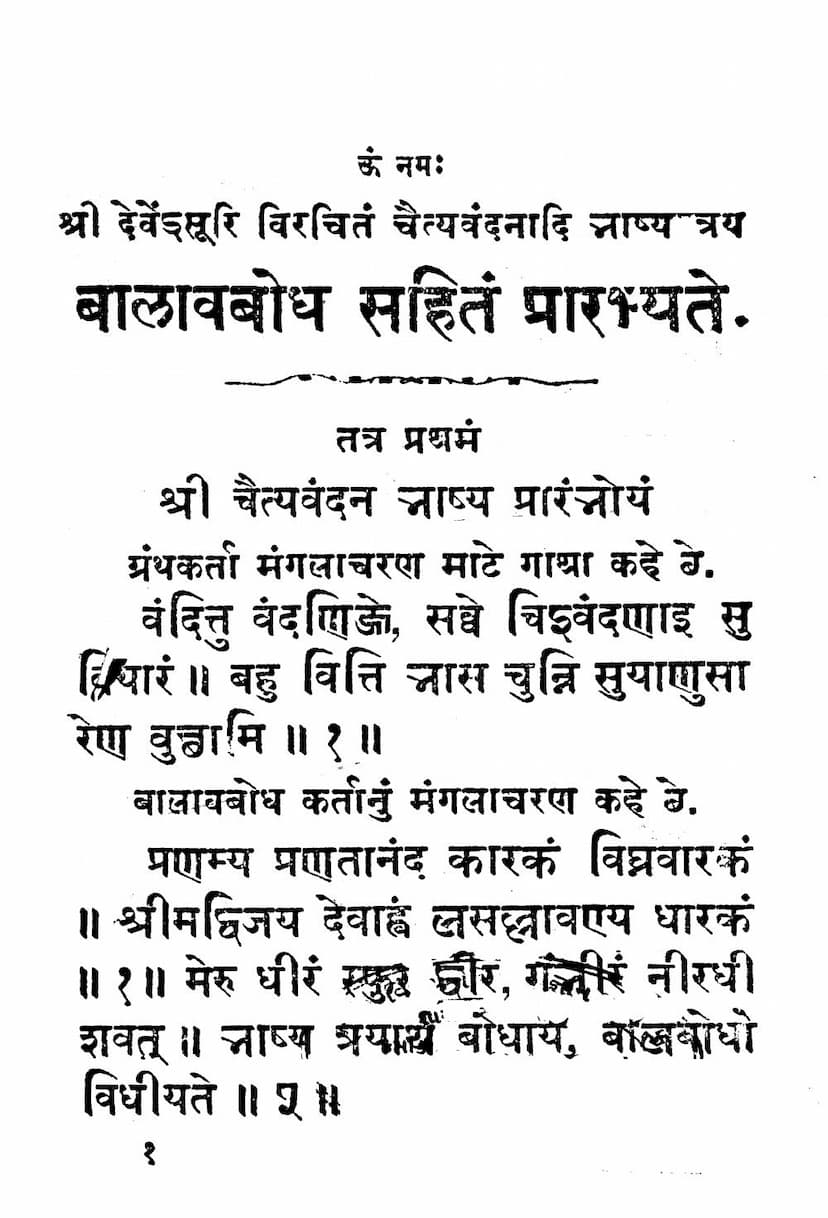Chaityavandanadi Bhashya Trayam Balavbodh Sahit
Added to library: September 1, 2025

Summary
Here's a comprehensive summary of the Jain text "Chaityavandanadi Bhashya Trayam Balavbodh Sahit" by Devendrasuri, based on the provided pages:
Book Title: Chaityavandanadi Bhashya Trayam Balavbodh Sahit (Discourses on Chaityavandanadi, the Three Parts, with Child-Friendly Explanations) Author: Devendrasuri Publisher: Unknown Catalog Link: https://jainqq.org/explore/022326/1
Overall Summary:
This Jain text, "Chaityavandanadi Bhashya Trayam Balavbodh Sahit," authored by Devendrasuri, serves as a detailed guide to performing Chaityavandana (veneration of Jain temples and deities) and related practices. The text is presented with a "Balavbodh," meaning it includes explanations aimed at making the complex rituals and philosophical underpinnings understandable, likely for younger or less experienced practitioners.
The book aims to systematically explain the various aspects of temple veneration, breaking down the process into distinct "dwara" (chapters or sections), each focusing on a specific element or rule. It emphasizes purity, proper conduct, and the philosophical reasoning behind each step, guiding the devotee towards a meaningful and correct observance of their faith.
Key Themes and Content Breakdown:
-
Mangalacharan (Invocation): Both the author (Devendrasuri) and the explainer (Balavbodh Karta) begin with auspicious verses, invoking deities and seeking blessings to commence the work.
-
Purpose of Devotion (Chaityavandana): The text clarifies that veneration is not mere ritual but a way to understand and internalize the true nature of pure deities (Arhantas), pure gurus, and pure Dharma. This understanding is presented as the foundation for "Samyakdarshan" (right faith). The text highlights the Arhantas as the pure, stainless, and faultless divine beings, worthy of worship through their installation and adoration.
-
The 24 Dwara (Sections) of Chaityavandana: The core of the text lies in its detailed breakdown of Chaityavandana into 24 distinct "dwara" or stages. The author lists the names and the number of sub-divisions (uttara bhed) for each dwara, presenting this information in a series of four verses. These 24 dwara cover a wide range of aspects, including:
- Types of Veneration: Describing different ways to offer salutations and prostrations.
- Etiquette and Conduct: Rules regarding direction, posture, speech, and handling sacred objects.
- Ritual Components: Explanations of mantras, stanzas, and the significance of various gestures.
- Philosophical Principles: Underlying concepts related to the purity of the devotee, the deity, and the ritual itself.
- Avoidance of Ashotana (Offenses): Detailed instructions on what to avoid within the temple premises to maintain sanctity and respect.
-
Detailed Explanation of Early Dwara: The text then proceeds to elaborate on the initial dwara, starting with:
- Dasha Trik (Ten Triads): The first dwara focuses on ten sets of three principles, which are elaborated upon through verses. These include principles related to specific postures, directions, types of offerings, and mental states.
- Naishidhika Trik (Three Prohibitions): The text explains the three instances of "Naishidhika," which involve ceasing worldly activities. These are categorized as related to one's home, the temple, and the act of worship itself.
- Pradakshina Trik (Three Circumambulations): Explaining the significance and practice of circumambulating the deity, often linked to the attainment of knowledge, perception, and conduct.
- Pranam Trik (Three Types of Prostration): Detailing different ways of bowing and offering salutations, such as Anjali Bandha, Ardha Namaskara, and Panchanga Namaskara.
- Puja Trik (Three Types of Worship): Discussing three forms of worship: Angapuja (worship with body parts), Agraputja (worship with offerings like incense, lamps, food), and Navapuja (worship through hymns and praises). It also touches upon the concept of Panchopachara (five offerings) and Ashtopachara (eight offerings).
- Avastha Trik (Three States of Being): Discussing the three states of the deity: Pindastha (embodied), Padistha (situated in knowledge), and Rupatita (transcendent of form).
- Trin Dishinirakshan (Avoiding Three Directions): Rules about not looking in certain directions while worshipping to maintain focus.
- Avagraha (Periods of Restraint): Explaining different permissible distances from the deity during worship.
- Tri-vidha Vandana (Three Types of Salutations): Detailing various levels of veneration.
- Dasa Ashatana (Ten Offenses): A crucial section highlighting ten actions that are considered offenses within the temple.
-
Detailed Breakdown of Later Dwara: The summary indicates that the text continues to explain the remaining dwara, covering aspects like:
- Nam Sthapana etc. (Four Types of Jin): The four forms of the Jin (names, representations, actual beings, and spiritual forms).
- Four Praises: Different types of devotional songs or hymns.
- Eight Reasons for Worship: The motivations behind performing veneration.
- Twelve Causes for Worship: The factors that lead to or facilitate worship.
- Sixteen Garudas (Sins to Avoid in Kanussagga): Specific restrictions during meditation.
- Twenty-Six Dosha (Faults in Kanussagga): Things to avoid during meditation.
- Kanussagga Pramana (Measure of Kanussagga): The duration or extent of meditation.
- Stavana (Praise): How to offer praise to the Vitaragas.
- Seven Times of Chaityavandana: The prescribed times for worship in a day.
- Ten Ashatana (Ten Offenses): A reiteration or further detail on prohibited actions.
-
Structure and Methodology: The text uses "Gatha" (verses) to explain concepts, followed by "Balavbodh" (child-like explanations) for clarity. The "Bhashya" (discourse or commentary) aspect refers to the detailed explanation of these verses and the underlying principles.
Significance:
This text is invaluable for understanding the meticulousness and depth of Jain devotional practices. It not only outlines the "how-to" of temple worship but also delves into the philosophical "why," connecting rituals to spiritual progress and the attainment of right faith. The inclusion of "Balavbodh" suggests an effort to make Jain teachings accessible across different levels of understanding.
In essence, "Chaityavandanadi Bhashya Trayam Balavbodh Sahit" is a comprehensive manual for Jain devotees, offering a structured, philosophical, and understandable approach to the fundamental practice of Chaityavandana.